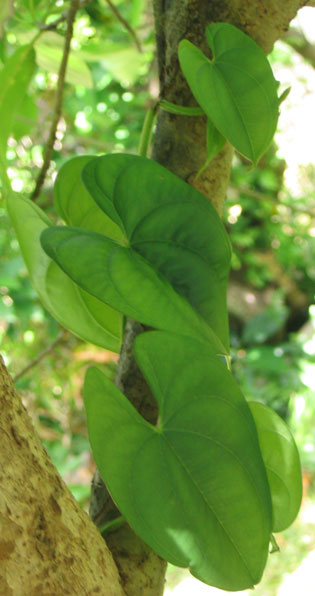Watch this space! This is one of the pages written in the prototype stage of this web site, which has been transferred with minimal changes to the newer format. It is still therefore "under construction", but contains the essential linguistic and botanical information, along with other material. Updated text and more pictures will be added progressively as soon as time permits (new pages for plant names not yet discussed are being given priority). If you would like this page to be updated sooner than planned, please email a note to temaarareo at gmail.com.
 A recognizable reflex of Proto Malayo-Polynesian *qubi (e.g. Tagalog ubi, Fijian uvi, Māori uhi or uwhi, signifies the "great yam" (Dioscorea alata) in many Austronesian languages, and functions as a term for yams in general in most of these. At least two related species, D. escuelenta and D. hispida, are also wdely grown in tropical Austronesia, but these have their own local or regional specific names. Perhaps because of the greater size and more spectacular appearance of its tubers, but also because it is easier to process than the other species, Dioscorea alata is the "default" referent of this name when a single species is the topic. It was carried into the Pacific by the Austronesian explorers, and widely cultivated throughout Polynesia from Hawaii and Easter Island to Aotearoa. Over 30 named varieties grown in Easter Island are listed in Jorge Fuentes' Diccionario, but the Williams' dictionary lists very few Mäori names (these are noted below). A recognizable reflex of Proto Malayo-Polynesian *qubi (e.g. Tagalog ubi, Fijian uvi, Māori uhi or uwhi, signifies the "great yam" (Dioscorea alata) in many Austronesian languages, and functions as a term for yams in general in most of these. At least two related species, D. escuelenta and D. hispida, are also wdely grown in tropical Austronesia, but these have their own local or regional specific names. Perhaps because of the greater size and more spectacular appearance of its tubers, but also because it is easier to process than the other species, Dioscorea alata is the "default" referent of this name when a single species is the topic. It was carried into the Pacific by the Austronesian explorers, and widely cultivated throughout Polynesia from Hawaii and Easter Island to Aotearoa. Over 30 named varieties grown in Easter Island are listed in Jorge Fuentes' Diccionario, but the Williams' dictionary lists very few Mäori names (these are noted below).
In Aotearoa uhi and the variant uwhi also functioned as a generic name for the significant tuberous root crops in general: kumara (Ipomoea batatas), para (uhi para, the fern Ptisana salicina), and the orchid Gastrodia cunninghamii (uhi perei). After the potato was introduced late in the eighteenth century a purple variety of potato was named uhi pō. Possibly the same variety was still known as uhi or uwhi in the Bay of Islands in the 1980s, when I was somewhat disappointed to find, after thinking that a friend's family was still cultivating yams, to find that the "uwhi" tubers he kindly offered me were a purple heritage potato -- nice to eat, and easy to grow, but not the vanished yam. The other names noted by Williams are ngangarangi (also applied to a variety of potato), pounamu (also a kumara variety) and uwhikāho (an alternative name for "yam").
Extensive cultivation of these plants in Aotearoa ceased soon after the introduction of the potato and more productive varieties of kumara, but a few families in the warmer districts, where the Dioscorea yam had been kept alive in such a marginally suitable climate for perhaps five hundred years, grew them on a very small scale for a few more decades, possibly into the twentieth century. Interestingly, the uhi does not seem to have been as important even in tropical Eastern Polynesia as it was in the west, and it became much less important there, too, after the introduction of alternative crops (cf. Louise Furey, Maori Gardening, p. 14).
Dioscorea alata is grown for ceremonial purposes and to enhance the prestige of the cultivator in many Melanesian societies -- the larger the tuber at harvest time, the greater the esteem. (I had a fine specimen growing in my garden in Honolulu, primarily for the attractive foliage, and the anthropologist Sir Raymond Firth, who "house sat" for us after I left for fieldwork in the Philippines, assured me that he well understood the importance of yams and would take good care of mine while we were away, which indeed he did.) In the Philippines, the purple variety of Dioscorea alata, while not an indicator of social status, is esteemed as an important ingredient in icecream and various desserts and cakes.
There is only a little known about the details of the clutivation of the uhi in Aotearoa. This is summarized in the Te Ara - Encyclopedia of New Zealand web site, also by Louise Furey in Maori Gardening (Wellington: DOC, 2006) and in Helen Leach's 1,000 years of Maori Gardening (Wellington: Reed 1984). Information about the cultivation and significance of different species of Dioscorea elsewhere in Oceania is given in Malcolm Ross et al., Proto Oceanic Lexicon, Vol 3, pp. 258-63 and Consuelo V. Asis et al., Plants of the Philippines, p. 71 (publication details in the bibliography). The Gallivant Tours web site -- http://gallivanttours.com/store/ -- had an entertaining note about one of the delicacies made from Dioscorea alata in the Philippines [but this had vanished when checked in 2023].
(We do not have any plants of Dioscorea alata growing in Te Māra Reo right now, but ... watch this space!)
|

